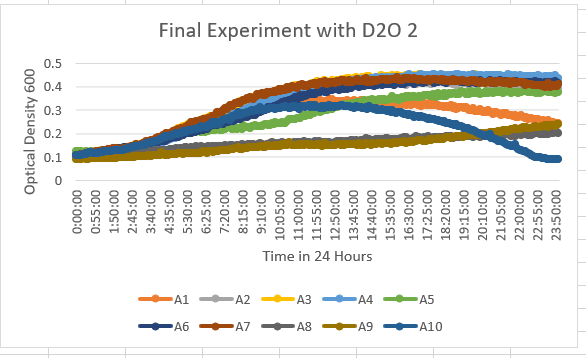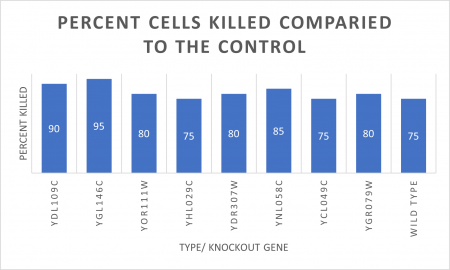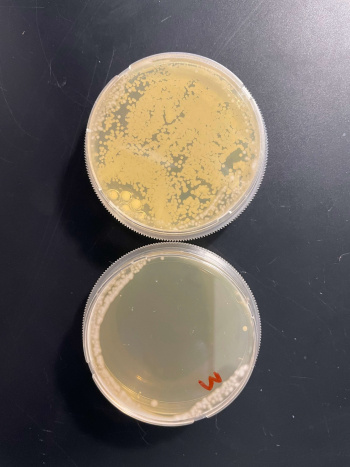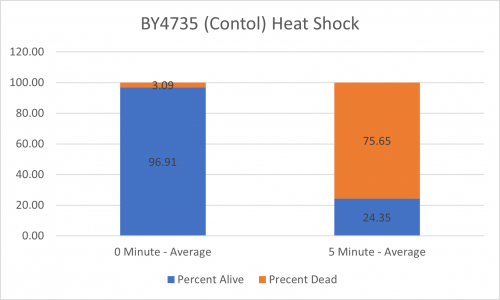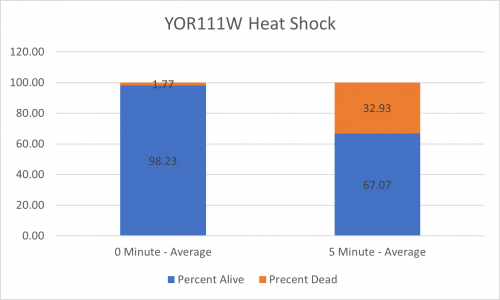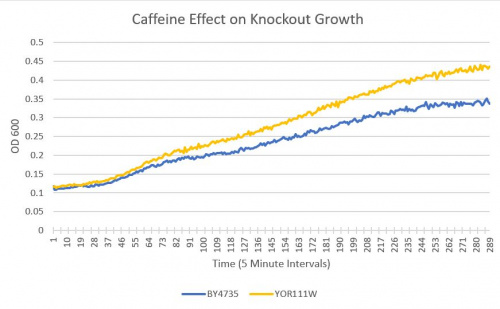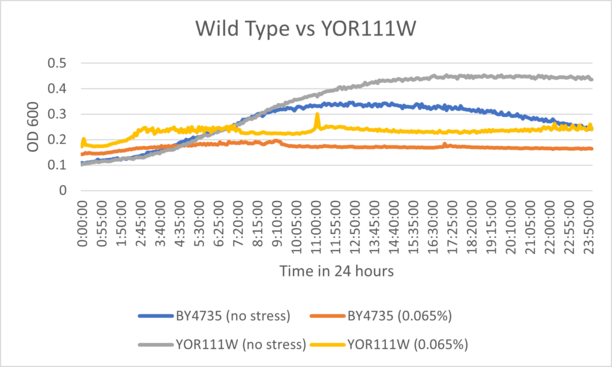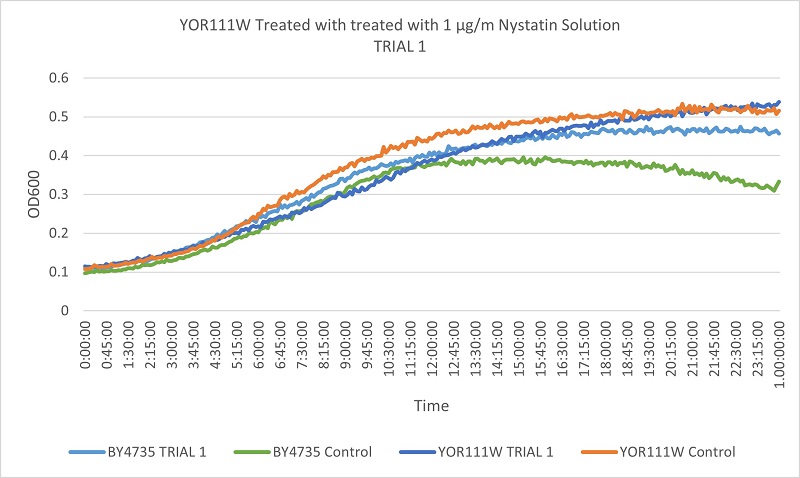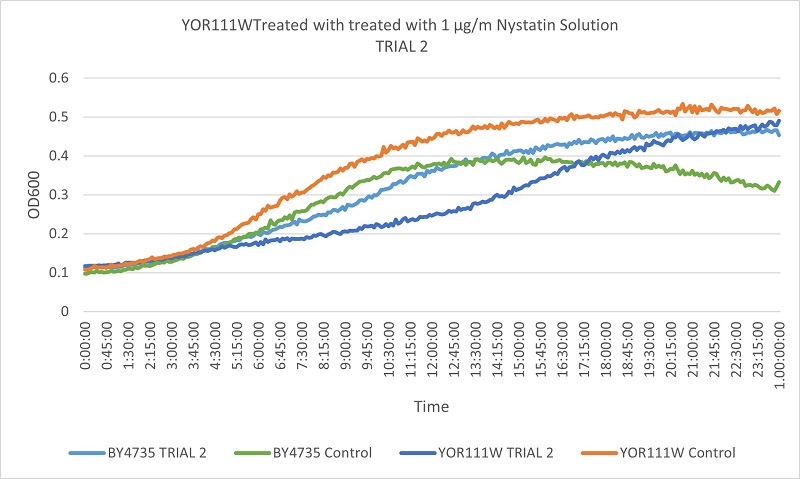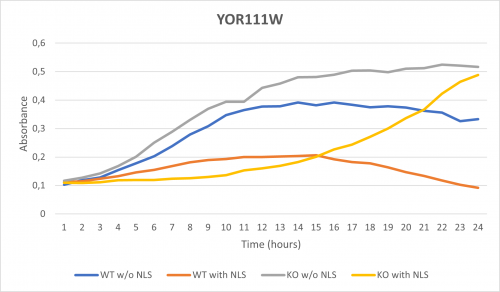Difference between revisions of "YOR111W"
(→Community Commentary) |
|||
| Line 160: | Line 160: | ||
====Interpretation==== | ====Interpretation==== | ||
The growth curve suggests that YOR111W may have some level of decreased sensitivity to oxidative stress. Both the knockout and control exhibited more growth than wild type cells in the same scenarios. While the difference in range for the cells treated with hydrogen peroxide is not large, it is at least notable as the knockout stayed above wild type consistently. | The growth curve suggests that YOR111W may have some level of decreased sensitivity to oxidative stress. Both the knockout and control exhibited more growth than wild type cells in the same scenarios. While the difference in range for the cells treated with hydrogen peroxide is not large, it is at least notable as the knockout stayed above wild type consistently. | ||
| + | |||
| + | ===[[UW Stout/Nystatin SP22]]=== | ||
| + | As part of the University of Wisconsin Stout [[UW-Stout/About|Orphan Gene Project]] this gene was tested by exposing the cells to 1µg/ml Nystatin solution. | ||
| + | ====Results==== | ||
| + | [[File:YOR-T1.jpg]] | ||
| + | [[File:YOR-T2.jpg]] | ||
==References== | ==References== | ||
Revision as of 19:21, 8 May 2022
Share your knowledge...Edit this entry! <protect>
| Systematic name | YOR111W |
| Gene name | |
| Aliases | |
| Feature type | ORF, Uncharacterized |
| Coordinates | Chr XV:530429..531127 |
| Primary SGDID | S000005637 |
Description of YOR111W: Putative protein of unknown function[1]
</protect>
Contents
Community Commentary
About Community Commentary. Please share your knowledge!
UW Stout/D2O SP22
The Knock Out Yeast Strain YOR111W (A3) was unaffected by the 35% dilution of the D2O. Due to the fact that is stayed in the Optical density of about 0.4-0.5 OD 600.
UW Stout/Sucrose Fermentation SP22
| Gene | Glucose | Fructose | Ethanol |
| Standard solution | 2.0000 | 0.2000 | 2.0000 |
| YDl109C | 0.3800 | 0.3933 | 0.3430 |
| YGL140C | 0.2212 | 0.2685 | 0.1867 |
| YOR111W | 0.3332 | 0.3598 | 0.1343 |
| YHL029C | 0.3870 | 0.2368 | 0.1151 |
| YDR307W | 0.4366 | 0.2487 | 0.0606 |
| YNL058C | 0.2710 | 0.3056 | 0.1577 |
| YCL049C | 0.4078 | 0.3052 | 0.1969 |
| YGR079W | 0.4042 | 0.1589 | 0.0080 |
| YBL113C | 0.3498 | 0.2012 | 0.1434 |
| BY4735 | 0.3171 | 0.3084 | 0.3541 |
This gene is part of the UW-Stout Orphan Gene Project. Learn more here.
<protect>
UW-Stout/UV Light SP22
As part of the University of Wisconsin Stout Orphan Gene Project this gene was tested under a UV Light using this protocol.
RESULTS
INTERPERTATION
In the graph and photos above, exposing this gene to 600 seconds of 400 Watt UV Light killed approximately 80% of yeast cell cultures, compared to its control counterpart, which was the same gene and amount of cells, just was not exposed to UV Light.
UW-Stout/Heat Shock SP22
As part of the University of Wisconsin Stout Orphan Gene Project this gene was tested by exposing the cells to heat shock.
Results
Interpretation
From the data gathered, there was a medium positive effect to knocking out this gene when it came to the yeast's ability to hold up to heat shock. The modified yeast cells were 275% more resistant to heat shock than the control.
UW-Stout/Caffeine SP22
As part of the University of Wisconsin Stout Orphan Gene Project this gene was tested by exposing the cells to 4mM of caffeine following this protocol.
Results
- BY4735(wild type yeast) and YOR111W(knockout yeast gene) growth after being subjected to 4mM caffeine solution.
Interpretation
As can be seen in the growth curve, YOR111W is more growth resistant to caffeine than the Wild-Type Yeast, boasting a Optical Density 600 measurement almost 30% higher.
UW-Stout/Hydrogen Peroxide SP22
As part of the University of Wisconsin Stout Orphan Gene Project this gene was tested by exposing the cells to hydrogen peroxide.
Results
BY4735 and YOR111W after being exposed to 0.065% dilution of hydrogen peroxide solution.
Interpretation
The growth curve suggests that YOR111W may have some level of decreased sensitivity to oxidative stress. Both the knockout and control exhibited more growth than wild type cells in the same scenarios. While the difference in range for the cells treated with hydrogen peroxide is not large, it is at least notable as the knockout stayed above wild type consistently.
UW Stout/Nystatin SP22
As part of the University of Wisconsin Stout Orphan Gene Project this gene was tested by exposing the cells to 1µg/ml Nystatin solution.
Results
References
See Help:References on how to add references
See Help:Categories on how to add the wiki page for this gene to a Category </protect>
UW-Stout/Nonionic Detergent SP22
As part of the University of Wisconsin Stout Orphan Gene Project this gene was tested by exposing the cells to 0.001% concentrated NLS. (Nonionic detergent)
Interpretations:
-According to the graph above, we can see that the KO yeast cell YOR111W follow a smaller sensitivity to the stress than the Wild type strain.
-The KO with NLS peaks a lot later than the KO w/o NLS
-We can then conclude that the knocked-out gene in YOR111W doesn't have a significant impact on the growth of the yeast cell.
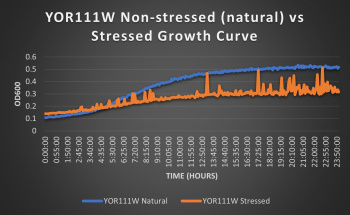 Knocked out gene seems to have some effect on cell growth in pH 7 environment based on the flattening of the growth curve. Spikes in stressed line are to be ignored; they occurred due to clumping of cells during analysis. We are focusing on the general linear trend of the growth curve. Please see protocol for specific quantitative doubling time results.
Knocked out gene seems to have some effect on cell growth in pH 7 environment based on the flattening of the growth curve. Spikes in stressed line are to be ignored; they occurred due to clumping of cells during analysis. We are focusing on the general linear trend of the growth curve. Please see protocol for specific quantitative doubling time results.
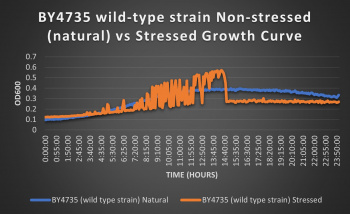 The wild-type strain was used as a control in this experiment; no genes were knocked out, it just represents how the experiment ran on the knocked-out gene strains affects a "typical" cell growth curve. Inclusion of this data on each knock-out strain growth curve graph made for difficult interpretation, so it has been separated. Please refer to this graph as a control when viewing the knock-out strain growth curve graph. Spikes in stressed line are to be ignored; they occurred due to clumping of cells during analysis. We are focusing on the general linear trend of the growth curve.
The wild-type strain was used as a control in this experiment; no genes were knocked out, it just represents how the experiment ran on the knocked-out gene strains affects a "typical" cell growth curve. Inclusion of this data on each knock-out strain growth curve graph made for difficult interpretation, so it has been separated. Please refer to this graph as a control when viewing the knock-out strain growth curve graph. Spikes in stressed line are to be ignored; they occurred due to clumping of cells during analysis. We are focusing on the general linear trend of the growth curve.
